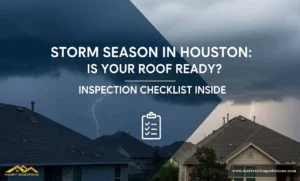
The Houston storm season is a unique challenge for homeowners, and can bring high winds, heavy rain, and hail that can be damaging to property, starting with your roof. Preparing your roof is not merely maintenance, but rather protecting your home and your family. We provides the knowledge you need to determine your roof’s preparedness for storms and find anything that might turn into a big problem down the road.
The Importance of a Pre-Storm Roof Inspection
A thorough roof inspection for the Houston storm season is your most effective proactive defense against storm roof damage. We recommend having a storm season roof inspection at Huston every year to identify any possible weaknesses and correct them before they become a challenge.
An accurate inspection by a Houston professional roofing company can find small weaknesses that are not visible from the ground. This preventative measure provides peace of mind for our customers and protects their homes. Given Houston’s unpredictable weather patterns, the damage that can occur in a single storm reinforces the importance of a storm inspection for your roofing system and residential property.
Roof Inspection Checklist for Storm Preparedness
A professional inspection is always best but there are some things homeowners can do to do a preliminary visual inspection. The following checklist will help you identify the areas to look at and encourage you to understand the condition of your roof and its preparedness for storms.
Exterior Inspection: Your Roof’s Advocate
- Shingles and Tiles: Look for missed, cracked, or curling shingles. These are indications of wear and tear, and could be susceptible to high winds. Even the smallest crack will permit water entry below.
- Flashing: Inspect flashing around the chimney, vents, and skylights- this is often a source of leaks when it is damaged or has deteriorated because it is the watertight seal.
- Gutters and Downspouts: Confirm that your gutters are clean and attached. If your gutters are filled with debris, your roof may not drain properly, leading to overflows or pooling water and fascia and foundation damage.
- Granule Loss: Look for shingle granules in your gutters or downspouts. If you observe excessive amounts of them, it may indicate that your shingles are deteriorating and nearing the end of their useful life, which may reduce their UV ray and impact protection.
- Soffits and Fascia: Inspect these areas for rot, decay, and water spots. These can often indicate water damage due to gutters not working properly or leaks in your roof.
- Trees and Branches: Cut back any branches touching or hanging over your roof. They can break off during a storm, falling and causing impact damage or punctures.
Interior Assessment: Discovering Hidden Problems
- Attic Evaluation: In your attic, look for water stains on wood, mold blooms, or wet insulation. Assess if you see daylight through the roof boards indicating a hole or gap.
- Ceilings and Walls: Look for water stains, discoloration, or peeling paint. Usually, these are the first visible signs of a slow leak.
Identifying Signs of Roof Damage After Storms
Storm roof damage can happen even if you have taken precautions. When the storm has passed, be sure to re-inspect your roof for new damage. Identifying signs of roof damage after a storm, and reporting them quickly, prevents minor problems from becoming major headaches. Some signs of roof damage can include:
- Visible Debris: Check your roof and inspection yard for fallen branches, missing shingles, or pieces of flashing.
- Dent in Gutters or Downspouts: Hail is heavy, and can cause large dents.
- Missing or Damaged Shingles: High winds can lift or tear shingles from your roof, leaving your roof decking exposed. Check for curled or creased shingles.
- Water Stains or Leaks: New water stains or spots on ceilings, walls or the carpet of the attic are instant indicators that something has acted upon the roof and has compromised it.
- Loose or Exposed Nails: If nails have popped out or are exposed to the elements they will create entrance points for water.
When to Call for Emergency Roof Repair in Houston
If you suffer heavy damage due to a storm, call for emergency roof repair in Houston immediately. Waiting will only lead to more damage, such as structural problems, mold growth, and interior water damage, and you will have a much bigger (and more expensive) problem on your hands.
We realize that the situation is urgent and we are available to you at all times (24/7) and we know that the decisions you make sooner rather than later are in the best interest of protecting your home. Additionally, our rapid response team can take care of the immediate threat and help you with temporary solutions.
Trust Our Roofing Solutions for Your Roof to be Prepared for Storms
Don’t wait for the next storm! Proactive roof maintenance and repairs are critical to keeping your house protected. You will want to call Hart Roofing Solutions today to schedule your roof inspection in Houston, where one of our experienced and knowledgeable field staff will assess your roof’s condition, document any existing problems, and recommend any necessary repairs ahead of Houston’s storm season. Your peace of mind is paramount. We want to help protect your home and family from the harsh climate Texas has to offer by ensuring that your roof is prepared for whatever Mother Nature throws your way!

